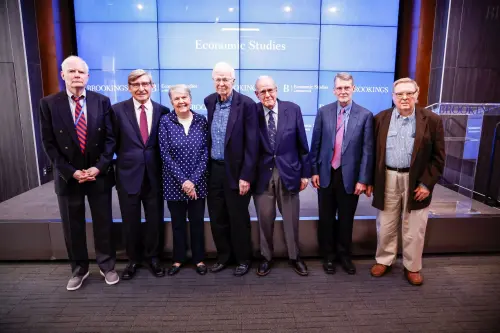It is simultaneously true that labor supply is not back to its pre-pandemic projected path and that labor demand is strong relative to supply. The result is a smaller but hot labor market.
In anticipation of the release of this month’s Employment Situation Report, we take stock of the size and composition of the labor force to identify both populations and policies that could contribute to gains in labor force participation. Such gains would increase labor market income and would help the economy grow without creating more inflationary pressure.
As of June 2022, the size of the labor force has shrunk relative to its pre-pandemic path: the labor force is roughly three- to three-and-a-half million workers smaller than its pre-pandemic projection.[1] A large portion of the decrease in the size of the labor force relative to pre-pandemic projections—approximately a third—has nothing to do with labor force participation. First, the population is smaller because of pandemic-related deaths. While those deaths have been concentrated among those 65 and older (three-quarters of a million), more than a quarter of a million pandemic-related deaths are estimated for those between the ages of 18 and 64. Second, there are ongoing pandemic- and policy-related factors that are depressing immigration.
The biggest decline in the labor force has been among those ages 55 and over, with those 65 and older accounting for about a third of the total decline, owing to a combination of death among this group and lower labor force participation. The declines in participation likely reflect early retirements, concerns about health, and to some extent excess disability and lower life expectancy caused by disability due to COVID-19.
The aggregate labor force participation rate (the share of the population over the age of 16 who is working or actively seeking work) remains depressed at 62.2 percent. This piece documents changes in labor force participation between June 2022 and two earlier periods: 2016 (when LFPR began to pick up after a sustained decline) and 2000 (when LFPR peaked). By controlling for the contribution of changing demographics to LFPR, we isolate the contribution of participation to the differences in LFPR from June 2022 to 2016 and 2000. This analysis explores the opportunities that a smaller but hotter labor market afford, identifies populations who could drive labor force growth, and points to public policy interventions that could increase labor force participation.
Trends in labor force participation due to demographics
Figure 1 shows monthly and annualized labor force participation rates from the late 1970s to today. As of June 2022, LFPR is 0.9 percentage points below its 2019 average rate.[2] It is also 0.6 percentage points below its 2016 rate—the year the rate began its three-year rebound after 15 years of decline. And, compared to its 2000 peak, LFPR is down 4.9 percentage points; LFPR’s peak in 2000 reflected rising labor force entry among women, whose participation rate grew by more than 20 percentage points between the early 1960s and the turn of the century.

The overall decline in LFPR from the early 2000s has largely reflected the aging of the population and the movement away from work for young adults in school, which more than offset the increase in LFPR from increases in educational attainment (both high school and postsecondary) and from older workers staying in the labor market longer. Labor force participation has also been influenced by the business cycle, declining in the aftermath of the Great Recession and the COVID-19 recession and then recovering as conditions improved. Aaronson et al. find that structural factors (such as aging, the trajectory of participation among certain demographic groups, and disability insurance takeup) could explain almost all of the decline in LFPR between 2007 and 2014.
Figure 2 shows the effects of changing demographics on labor force participation. The figure shows two dashed lines that represent what the labor force participation rate would have been had the age, education, and sex distribution stayed the same but other factors continued to affect LFPR. Holding age, education, and sex constant at 2000 levels (the green line), the LFPR low point would have been 64.5 percent in 2020, rather than 61.8 percent; in other words, population aging and other demographic factors contributed 2.7 percentage points to the difference in LFPR between 2000 and 2020 and changing participation rates within groups 2.5 percentage points.[3] Additionally, even in the relatively short period since 2016, changes in demographics have pulled down LFPR. As shown by the gap between the blue dashed line and the black line, changing demographics lowered, on net, LFPR in June 2022 by 1.1 percentage points.

Changes in participation unrelated to demography
Although demographics explained most of the decline in LFPR from 2000 to 2009, other factors pushing down LFPR became increasingly apparent and important after the Great Recession through 2016. Indeed, at the time, policymakers, economists, and other observers had significant concerns that LFPR was continuing to decline even as other parts of the economy recovered. Then, from 2016 through just before the pandemic, LFPR rose even as demographics, on net, pushed it down. That experience offers evidence that factors can indeed push up labor force participation within demographic groups.
Figure 3a shows how changing labor force participation rates among different demographic groups contributed to the net change in LFPR from 2016 to June 2022 (shown in the blue dashed line in Figure 2). Figure 3b decomposes the change since 2000 (shown in the green dashed line in Figure 2). These decompositions show how LFPR has changed within demographic groups, that is, the portion of the labor force participation rate that changes with the propensity for different demographic groups to work. We find that groups with lower LFPRs than in prior periods have room for further recovery in LFPR, under the right conditions.
The contribution to LFPR of different groups’ propensity to work: 2016-June 2022
While on net LFPR as of June 2022 is still below its 2016 rate, some groups are participating at higher rates while others at lower rates. From 2016 to June 2022, women made the greatest positive contribution to the overall labor force participation rate, netting an increase of 0.4 percentage points, compared to men at 0.1 percentage point. Prime-age (25- to 54-year-old) women increased aggregate LFPR by 0.1 percentage points while prime-age men reduced it by 0.1 percentage points. Among prime-age men, the biggest decline came from men without a bachelor’s degree. The decline for women between 45 and 54 with less than a bachelor’s degree was also sizable.
In 2019, half of all prime-age women who were in the labor force had children under the age of 18. Women handled the brunt of child care responsibilities during COVID-19 and were the most likely to leave the labor force. Based on this analysis, women under 44 are more than back to their pre-COVID participation. Women between the ages of 25 and 44 added about a fifth of a percentage point to LFPR since 2016; more than two-thirds of that gain can be attributed to women with at least a bachelor’s degree.
Young people—those between the ages of 16 and 24—had the largest positive contribution to LFPR from 2016 to June 2022; men and women between the ages of 16 to 24 with less than a college degree added more than 0.6 percentage points to LFPR during that period.
For people 55 and over, a declining propensity to work reduced LFPR by 0.1 percentage points. Men with bachelor’s degrees over the age of 55 and women over the age of 65 collectively reduced LFPR by 0.3 percentage points from 2016 to June 2022; in some cases, these may have been early retirements spurred by COVID-19. Interestingly, less educated men ages 45 and older increased aggregate LFPR by 0.1 percentage point; more than half of this increase came from the 65+ age group.

The contribution to LFPR of different groups’ propensity to work: 2000-June 2022
Figure 3b decomposes the labor force participation rate between 2000 to June 2022 (holding demographics constant), helping to put the changes since 2016 in a longer-term context. Nearly three quarters of the decline since 2000 is attributable to the 16-24 group, whose pivot toward exclusive schooling consequentially explains their movement away from work; it remains to be seen whether the magnitude of the 2016 to June 2022 rebound will persist, partly reversing the long-term trend.
Men and women ages 25 to 54 with less than a bachelor’s reduced overall labor force participation by 0.81 percentage points and 0.83 percentage points, respectively, since 2000. To be sure, some structural factors not accounted for here help to explain those declines. For example, the flow of net international migration to the United States has decreased substantially since 2016. Because immigrants tend to have higher LFPRs, that decrease puts downward pressure on the aggregate LFPR. Nonetheless, the high-water mark in 2000 suggests room for more significant increases in LFPRs among prime-age people than if we just compare current conditions to those in 2016.
For all groups over the age of 55, LFPRs have been higher since 2000 even though some of these groups saw decreases since 2016. For a time, improving health at older ages and changes in work conditions drove LFPRs up among older workers, but the COVID-19 pandemic dramatically altered those trends, both in terms of the health of older workers and the risk that working posed to them. However, even after the pandemic has receded as a factor determining LFPR, the past few years may have shown that LFPRs among older people will not persistently rise as predicted. For example, a greater share of the increases in LFPRs among older people in the decade after the Great Recession may have been a temporary response to the loss of wealth and earnings early in that period; the increase in wealth from equity and real estate prices in 2020 and 2021 along with the health effects of the pandemic may have abruptly ended that response.
Comparing LFPRs among different groups between June 2022 and both 2016 and 2000 shows where history suggests there is the potential for increases. Among prime-age people—particularly among men and among people without a bachelor’s degree—comparisons to earlier years suggests room for substantial increases. In contrast, the recent decreases in LFPR among older workers still leaves participation rates higher than in 2000. Improvements among that group depend on whether the pandemic persistently altered the trends that had been pushing up LFPRs. In addition, the increases among younger workers may not be durable if those ages 16 to 24 return to going to school exclusively.
How Can the Labor Market Grow Through Increased Participation?
Based on this analysis, is there room for the labor market to grow? Yes.
The factors that have depressed labor force participation among older people and that have increased labor demand in general have led to opportunities for younger workers; but, this has not led to uniformly higher participation for all groups under age 65. Most significantly, participation is still depressed for prime-age men—particularly those without a bachelor’s degree. The decline for women between 45 and 54 with less than a bachelor’s degree has also been sizable. If LFPR came back to its pre-pandemic trend for those groups, the labor force would be larger by hundreds of thousands of workers.
Hot labor market conditions in 2016-19 pulled less educated prime-age men off the sidelines and into the labor market. These men are likely more responsive to current labor market demand-side factors than older workers. And indeed, men with less than a bachelor’s over the age of 45 were participating at a higher rate in June 2022 than in 2016. However, the experience of 2016-2019 showed that these men responded to an improvement in labor market conditions with a considerable lag. Even though participation remains depressed among less educated men under 45, policymakers should continue to focus on encouraging participation among this group.
Moreover, policymakers should not take for granted the increases in participation seen so far among other groups. On the whole, prime-age women have increased their LFPR relative to 2016 lows. However, those gains may have come at great personal cost among women with young children and other care responsibilities during the pandemic. Moreover, LFPRs among prime-age women with less than a bachelor’s are still well below the levels in 2000. This group should garner the attention of policymakers hoping to increase the size of the labor market, and The Hamilton Project has put out policy proposals that improve productivity and room for advancement in jobs that require less formal education.
In order to pull people off the sidelines, policies that spur productivity and wage growth, remove barriers to entry, invest in workforce development, and increase the returns to work for those with lower wages through the Earned Income Tax Credit will be crucial. As the ongoing COVID-19 pandemic becomes endemic, proposals that allow people with disabilities to more fully engage in the labor market are essential to help improve participation. Policy proposals to support women in the workforce, whether by increasing the returns to work or by supporting caregiving and child care responsibilities, will allow women to not only enter but stay in the labor force.
[1] Calculating the changes in the sizes of the population and labor force relative to pre-pandemic projections is less straightforward than it might appear. In January 2022, the US Bureau of Labor Statistics updated its population estimates for household survey data to introduce the blended 2020 decennial census to the population composition and size. This revision was incorporated into the data starting in 2022, which implies revisions to early years. That makes 2022 estimates of labor force participation and the labor force look somewhat better than the years leading into the pandemic for technical reasons. If one adds the increase in the size of the labor force between December 2021 and January 2022 to 2022 Q2 and compares it with the labor force projection from the Congressional Budget Office (CBO) in January 2020: the size of the difference between the CBO projection plus the January increase and June 2022 is about three-and-a-half million. One would arrive at the three million number if instead one extrapolates pre-pandemic trends to determine the labor force projection alongside the annual revisions to the size of the population; in other words, the size of the difference between the actual labor force and the pre-pandemic trend is roughly three million.
[2] As detailed in footnote 1, the one-time population revision incorporated into the monthly CPS exaggerates the progress made in closing the LFPR gap between 2019 and 2022.
[3] Throughout this analysis, we hold age, sex, and education constant to document the contribution of changing labor force participation within these groups. Were we to hold only age and sex fixed, the counterfactual LFPR (shown in the dashed lines in figure 2) in June 2022 would have been 63.7 percent (2016 age and sex demographics held constant) and 66.9 percent (2000 age and sex demographics held constant).
The Brookings Institution is financed through the support of a diverse array of foundations, corporations, governments, individuals, as well as an endowment. A list of donors can be found in our annual reports, published online. The findings, interpretations, and conclusions in this report are solely those of its author(s) and are not influenced by any donation.
-
Acknowledgements and disclosures
The authors would like to thank Gary Burtless, Este Griffith, Brad Hershbein, Martha Ross, and Marie Wilken for their feedback on an earlier version of this piece. Mitchell Barnes, Joy Dada, Luiza Macedo, and Moriah Macklin provided exceptional research support.










Commentary
Can a hot but smaller labor market keep making gains in participation?
Thursday, August 4, 2022